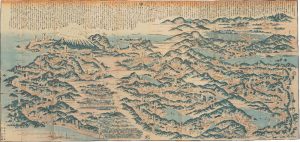2023–24 Core Program
Open Edo: Diverse, Ecological, and Global Perspectives on Japanese Art, 1603–1868
–organized by Kristopher W. Kersey (Art History, University of California, Los Angeles)

The art of Japan’s Edo period (1603–1868) presents a paradox. On the one hand, the nineteenth-century proliferation of ukiyo-e—polychrome woodblock prints of the “floating words” of theater and sex work—made the popular visual culture of this city a familiar component of modern art in the nineteenth and twentieth centuries. Yet the outsize fascination with ukiyo-e outside Japan has sorely obscured Edo’s far more diverse social, material, and artistic landscapes. In an effort to countervail the enduring stereotypes of early modern Japanese art, Open Edo will present a suite of conferences addressing three interlinked themes: the representation and agency of marginalized groups, the ecological horizons of artistic production, and the ongoing need to counter the myth that Japan in early modernity was somehow disconnected from the rest of the world. Throughout the year-long series, the focus will be both historical and historiographical inasmuch as Open Edo asks how Japanese art history might challenge the discourse of early modernity writ large. Each conference will incorporate a site visit to an Edo-period archival resources in Southern California. At the conclusion of the year, selected papers will be assembled for publication in the UCLA Clark Memorial Library Series.
Conference 1
Global Edo: Edo in the World and the World in Edo
October 13, 2023
The subject of this initial conference is the longstanding myth that Japan was hermetically sealed from the rest of the world from the 1630s to 1853. While international travel and trade were indeed forbidden, Japan remained networked with the those beyond its shores through trade with the continent, the Dutch, the Ainu, and the Ryūkyūs. During this period, fantasies of Japan proliferated abroad, just as fantasies of the outside world proliferated in Japan. Yet the restrictions on international exchange did not mean that Japan was somehow isolated from modernity. In fact, the metropolis of Edo actually exhibited many of the aspects that would later come to be seen as “modern” by the European definition of the term. Put more forcefully, early modernity seemed to thrive in a society that eschewed the Eurocentric model of “globalization.” Likewise, one should not conflate the Edo metropolis with the eponymous era, for an exciting feature of early modern Japan is the existence of multiple metropolitan centers, from Osaka and Kyoto to Nagasaki. As such, this initial conference seeks papers that will reframe the Edo period in more porous, global, networked, and dynamic terms.
Conference 2
Eco Edo: Ecological Perspectives on Early Modern Japanese Art
February 2, 2024
The highly urbanized nature of the Edo period—with its three metropolises of Osaka, Kyoto, and Edo—resulted in massive changes to the natural and built environments. The bustling economies of these cities fueled wide-reaching networks of production, trade, and environmental exploitation. The concept of nature itself, as well as the iconography of natural history, were likewise in flux. Accordingly, this conference seeks papers that will contribute to the emergent discourse of ecological art history by directing attention to the material and ecological horizons of early modern Japanese art. What were the aesthetics of environmental exploitation? How were industry and labor depicted? What were the religious perspectives on ecological manipulation? How were materiality and ecology themselves conceived? Where is the intersection of ecological ethics and artistic production?
Conference 3
Edo Outsiders: Ainu and Ryūkyūan Art
April 19, 2024
To this day, many mistake Japan for a culturally homogenous society, yet this nationalistic myth is far from the truth. In an effort to underscore the diversity of early modern Japan, this conference will direct attention to two groups who are often marginalized if not absent in narratives of early modern Japanese art. To the south are the Ryūkyūans, whose Kingdom of Ryūkyū was reduced in the Edo period to a vassal state. To the north are the Ainu, an indigenous society progressively dispossessed of its lands throughout Japanese history. Recent anniversaries—the 150th anniversary of settler colonialism in Hokkaidō and the fiftieth anniversary of the reversion of the Ryūkyūs from the USA to Japan—have brought renewed critical attention to the art of these two marginalized groups. While much scholarship on Ryūkyūan and Ainu art has focused on modernity, this conference seeks to shift the focus deeper in the archive, to the seventeenth to eighteenth centuries.

